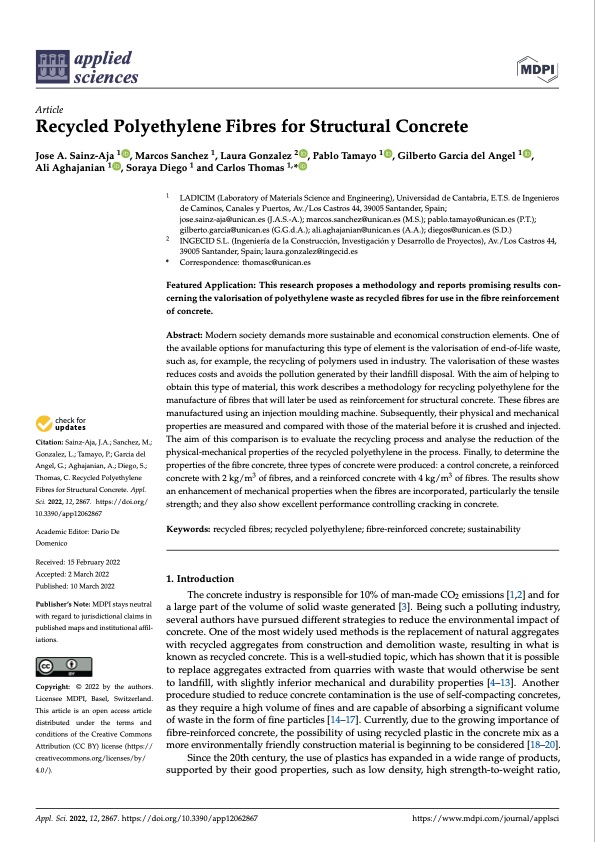
PDF Publication Title:
Text from PDF Page: 001
applied sciences Article Recycled Polyethylene Fibres for Structural Concrete Jose A. Sainz-Aja 1 Ali Aghajanian 1 , Marcos Sanchez 1, Laura Gonzalez 2 , Pablo Tamayo 1 , Gilberto Garcia del Angel 1 , , Soraya Diego 1 and Carlos Thomas 1,* * Correspondence: thomasc@unican.es Featured Application: This research proposes a methodology and reports promising results con- cerning the valorisation of polyethylene waste as recycled fibres for use in the fibre reinforcement of concrete. Abstract: Modern society demands more sustainable and economical construction elements. One of the available options for manufacturing this type of element is the valorisation of end-of-life waste, such as, for example, the recycling of polymers used in industry. The valorisation of these wastes reduces costs and avoids the pollution generated by their landfill disposal. With the aim of helping to obtain this type of material, this work describes a methodology for recycling polyethylene for the manufacture of fibres that will later be used as reinforcement for structural concrete. These fibres are manufactured using an injection moulding machine. Subsequently, their physical and mechanical properties are measured and compared with those of the material before it is crushed and injected. The aim of this comparison is to evaluate the recycling process and analyse the reduction of the physical-mechanical properties of the recycled polyethylene in the process. Finally, to determine the properties of the fibre concrete, three types of concrete were produced: a control concrete, a reinforced concrete with 2 kg/m3 of fibres, and a reinforced concrete with 4 kg/m3 of fibres. The results show an enhancement of mechanical properties when the fibres are incorporated, particularly the tensile strength; and they also show excellent performance controlling cracking in concrete. Keywords: recycled fibres; recycled polyethylene; fibre-reinforced concrete; sustainability 1. Introduction The concrete industry is responsible for 10% of man-made CO2 emissions [1,2] and for a large part of the volume of solid waste generated [3]. Being such a polluting industry, several authors have pursued different strategies to reduce the environmental impact of concrete. One of the most widely used methods is the replacement of natural aggregates with recycled aggregates from construction and demolition waste, resulting in what is known as recycled concrete. This is a well-studied topic, which has shown that it is possible to replace aggregates extracted from quarries with waste that would otherwise be sent to landfill, with slightly inferior mechanical and durability properties [4–13]. Another procedure studied to reduce concrete contamination is the use of self-compacting concretes, as they require a high volume of fines and are capable of absorbing a significant volume of waste in the form of fine particles [14–17]. Currently, due to the growing importance of fibre-reinforced concrete, the possibility of using recycled plastic in the concrete mix as a more environmentally friendly construction material is beginning to be considered [18–20]. Since the 20th century, the use of plastics has expanded in a wide range of products, supported by their good properties, such as low density, high strength-to-weight ratio, Citation: Sainz-Aja, J.A.; Sanchez, M.; Gonzalez, L.; Tamayo, P.; Garcia del Angel, G.; Aghajanian, A.; Diego, S.; Thomas, C. Recycled Polyethylene Fibres for Structural Concrete. Appl. Sci.2022,12,2867. https://doi.org/ 10.3390/app12062867 Academic Editor: Dario De Domenico Received: 15 February 2022 Accepted: 2 March 2022 Published: 10 March 2022 Publisher’s Note: MDPI stays neutral with regard to jurisdictional claims in published maps and institutional affil- iations. Copyright: © 2022 by the authors. Licensee MDPI, Basel, Switzerland. This article is an open access article distributed under the terms and conditions of the Creative Commons Attribution (CC BY) license (https:// creativecommons.org/licenses/by/ 4.0/). 1 LADICIM (Laboratory of Materials Science and Engineering), Universidad de Cantabria, E.T.S. de Ingenieros de Caminos, Canales y Puertos, Av./Los Castros 44, 39005 Santander, Spain; jose.sainz-aja@unican.es (J.A.S.-A.); marcos.sanchez@unican.es (M.S.); pablo.tamayo@unican.es (P.T.); gilberto.garcia@unican.es (G.G.d.A.); ali.aghajanian@unican.es (A.A.); diegos@unican.es (S.D.) 2 39005 Santander, Spain; laura.gonzalez@ingecid.es INGECID S.L. (Ingeniería de la Construcción, Investigación y Desarrollo de Proyectos), Av./Los Castros 44, Appl. Sci. 2022, 12, 2867. https://doi.org/10.3390/app12062867 https://www.mdpi.com/journal/applsciPDF Image | Recycled Polyethylene Fibres for Structural Concrete

PDF Search Title:
Recycled Polyethylene Fibres for Structural ConcreteOriginal File Name Searched:
applsci-12-02867.pdfDIY PDF Search: Google It | Yahoo | Bing
Development of a solar powered Electric Ship The Electricship website originally started off as a project to develop a comprehensive renewable, affordable, modular electric ship... More Info
Modular Boat Hull Composite The case for a unsinkable, modular composite hybrid boat hull... More Info
MS Burgenstock Hybrid Electric Catamaran Lake Lucerne Unique shuttle servicing Lucerne to the Burgenstock Resort... More Info
Ground Power Unit GPU Powered by Lithium Ion Batteries The goal of the Ground Power Unit is to provide a readily accessible, modular, ready-to-power solution for remote power... More Info
| CONTACT TEL: 608-238-6001 Email: greg@electricship.com | RSS | AMP |